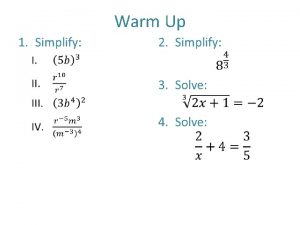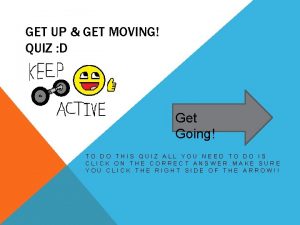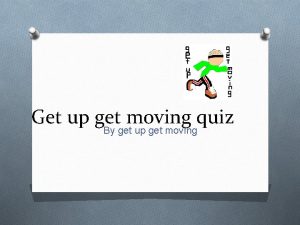WARM UP Get your warm up from the



























- Slides: 27

WARM UP • Get your warm up from the desk and complete it. You have 3 minutes to do the warm up after the bell rings. • Warm ups can only be done in the time allowed. No make ups. • Turn in the warm up. • Teacher will give the correct answer after all of them have been handed in.

WARM UP • Warm ups can only be done in the time allowed. No make ups. • Turn in the warm up. • Teacher will give the correct answer after all of them have been handed in.

I WILL BE ABLE TO: • • Define the types of fingerprints Recognize the types of patterns Take a clear and readable print Analyze patterns

“Fingerprints cannot lie, but liars can make fingerprints. ” -unknown

Digital Storytelling Fingerprint Analysis Watch the movie about fingerprints, patterns, and how to analyze them.


T. Trimpe 2006 http: //sciencespot. net

Fingerprint Principles According to criminal investigators, fingerprints follow 3 fundamental principles: • A fingerprint is an individual characteristic; no two people have been found with the exact same fingerprint pattern. • A fingerprint pattern will remain unchanged for the life of an individual; however, the print itself may change due to permanent scars and skin diseases. • Fingerprints have general characteristic ridge patterns that allow them to be systematically identified.

Fingerprint Classes There are 3 specific classes for all fingerprints based upon their visual pattern: arches, loops, and whorls. Each group is divided into smaller groups as seen in the lists below. Arch Plain arch Tented arch Loop Radial Loop Ulnar loop Whorl Plain whorl Central pocket whorl Double loop whorl Accidentical

Interesting Info Fingerprint Factoid: 60% of people have loops, 35% have whorls, and 5% have arches Did you know? Dactyloscopy is the study of fingerprint identification. Police investigators are experts in collecting “dactylograms”, otherwise known as fingerprints.

Arches are the simplest type of fingerprints that are formed by ridges that enter on one side of the print and exit on the other. No deltas are present. Spike or “tent” Plain Arch Ridges enter on one side and exit on the other side. Tented Arches Similar to the plain arch, but has a spike in the center.

Left Hand Loops must have one delta and one or more ridges that enter and leave on the same side. These patterns are named for their positions related to the radius and ulna bones, i. e. the bone the loop opening is facing towards. Ulna Radius Delta L – Radial Loop R - Ulnar Loop L – Ulnar Loop R - Radial Loop X-Ray Imagine: http: //www. tooloop. com/wp-content/uploads/2013/12/Radius-Ulna-X-Ray. jpg

Whorls have at least one ridge that makes (or tends to make) a complete circuit. They also have at least two deltas. If a print has more than two deltas, it is most likely an accidental. Plain Whorl Central Pocket Whorl Draw a line between the two deltas in the plain and central pocket whorls. If some of the curved ridges touch the line, it is a plain whorl. If none of the center core touches the line, it is a central pocket whorl.

Whorls – Part 2 Double Loop Whorl Accidental Whorl Delta Double loop whorls are made up of any two loops combined into one print. Accidental whorls contain two or more patterns (not including the plain arch), or does not clearly fall under any of the other categories.

Identify each fingerprint pattern. Right Hand Left Hand

It’s time to make some prints! Avoid Partial Prints GOOD PRINT Get as much of the top part of your finger as possible!

Directions 1 st – Roll the “pad” portion of your thumb over the ink pad from the left side of your thumb to the right. You do not have to push down really hard! 2 nd – Roll the “pad” portion of your thumb from the left side of your thumb to the right in the correct box on your paper to make a thumbprint. 3 rd – Continue this process to make a fingerprint of all ten fingers on the “My Prints” worksheet. 4 th –Use your notes and a magnifying lens to help you figure out what type of pattern is found in each of your fingerprints. Label each one with the pattern’s name.

Activity • You took your fingerprints once, now let’s try doing it correctly and taking a closer look at your own prints. • Follow the directions on how to get a good print. • You will take a print of each finger and thumb on both hands. • Place each print on the handout provided. Make sure your name is on the handout.

Stop for the Day

Forensic Science T. Trimpe 2007 http: //sciencespot. net/

Latent prints are impressions left by friction ridge skin on a surface, such as a tool handle, glass, door, etc. Prints may be collected by revealing them with a dusting of black powder and then lifted with a piece of clear tape. Did you know? Camel hair is the most common animal hair used to make fingerprint brushes. Now many brushes (like the one above) are made out of fiberglass.

Some investigators use fluorescent powder and UV lights to help them find latent prints on multi-colored or dark surfaces. Magnetic powder can also be used to reveal latent prints. This type of powder works better on shiny surfaces or plastic baggies or containers. The cyanoacrylate fuming method (often called the super glue method) is a procedure that is used to develop latent fingerprints on a variety of objects. Ninhydrin is a chemical that bonds with the amino acids in fingerprints and will produce a blue or purple color. It is used to lift prints from surfaces such as paper and cardboard. Click the icon to view the Crime 360 Super Glue Video Top Left: http: //www. stapletonandassociates. com/images/Mag. Powder. jpg Bottom Left: http: //www. ok. gov/osbi/images/ninhydrin%20 print. jpg Bottom Right: http: //www. forensicsrus. com/images/Superglue. Print. jpg

A Closer Look at Fingerprints Image from ftp: //sequoyah. nist. gov/pub/nist_internal_reports/ir_6534. pdf T. Trimpe 2007 http: //sciencespot. net/

Ridgeology: The study of the uniqueness of friction ridge structures and their use for personal identification. 1 As we have learned in our first lesson, a fingerprint is made of a series of ridges and valleys on the surface of the finger. The uniqueness of a fingerprint can be determined by the pattern of ridges and valleys as well as the minutiae points, which are points where the ridge structure changes. The koala is one of the few mammals (other than primates) that has fingerprints. In fact, koala fingerprints are remarkably similar to human fingerprints; even with an electron microscope, it can be quite difficult to distinguish between the two. 1 Introduction to Basic Ridgeology by David Ashbaugh, May 1999 Image from http: //www. cs. usyd. edu. au/~irena/minutia. gif

Fingerprint Identification When minutiae on two different prints match, these are called points of similarity or points of identification. At this point there is no international standard for the number of points of identification required for a match between two fingerprints. However, the United Kingdom requires a minimum sixteen points while Australia requires twelve. Automated Fingerprint Identification System (AFIS) AFIS is a computerized system capable of reading, classifying, matching, and storing fingerprints for criminal justice agencies. Quality latent fingerprints are entered into the AFIS for a search for possible matches against the state maintained databases for fingerprint records to help establish the identity of unknown deceased persons or suspects in a criminal case. http: //www. fdle. state. fl. us/Crime. Lab/images/fingerrint%20 comparison%20 for%20 afis. jpg

Ridge Characteristics Use these characteristics as points of identification when comparing fingerprint samples. The more points you can find in common, the better the match!

How many ridge characteristics can you identify in this fingerprint? http: //www. dkfz. de/tbi/projects/bmcv/images/iu_it 246_04 s_fingerprint 1. jpg
 Get on get off
Get on get off One direction one thing lyrics
One direction one thing lyrics Get up get moving quiz
Get up get moving quiz Get up get moving quiz
Get up get moving quiz Get up get moving quiz
Get up get moving quiz What is selection in pseudocode
What is selection in pseudocode Get focused get results
Get focused get results Get up get moving quiz
Get up get moving quiz Give us your hungry your tired your poor
Give us your hungry your tired your poor Hình ảnh bộ gõ cơ thể búng tay
Hình ảnh bộ gõ cơ thể búng tay Ng-html
Ng-html Bổ thể
Bổ thể Tỉ lệ cơ thể trẻ em
Tỉ lệ cơ thể trẻ em Chó sói
Chó sói Glasgow thang điểm
Glasgow thang điểm Chúa yêu trần thế
Chúa yêu trần thế Các môn thể thao bắt đầu bằng tiếng đua
Các môn thể thao bắt đầu bằng tiếng đua Thế nào là hệ số cao nhất
Thế nào là hệ số cao nhất Các châu lục và đại dương trên thế giới
Các châu lục và đại dương trên thế giới Cong thức tính động năng
Cong thức tính động năng Trời xanh đây là của chúng ta thể thơ
Trời xanh đây là của chúng ta thể thơ Cách giải mật thư tọa độ
Cách giải mật thư tọa độ Phép trừ bù
Phép trừ bù Phản ứng thế ankan
Phản ứng thế ankan Các châu lục và đại dương trên thế giới
Các châu lục và đại dương trên thế giới Thể thơ truyền thống
Thể thơ truyền thống Quá trình desamine hóa có thể tạo ra
Quá trình desamine hóa có thể tạo ra Một số thể thơ truyền thống
Một số thể thơ truyền thống

















































